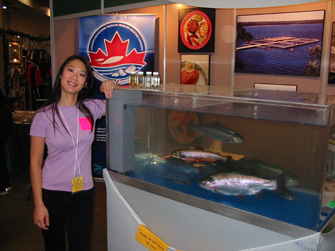AQUACULTURE STUDENT

STEPHANIE YUE
What They Did Back Then
* Bachelor of Science, animal behaviour, completed 1999, University of Toronto
* Master of Science, applied ethology, completed 2001, University of Guelph
* Doctor of Philosophy, applied ethology, completed 2006, University of Guelph
Advisor: Professor Richard D. Moccia
Fear and avoidance responses in the domestic rainbow trout.
ABSTRACT
Welfare is determined by the quality of an animalís
subjective experiences; these experiences in fishes remain
largely unknown. This thesis investigated avoidance
behaviour and the nature of fear, a negative subjective
experience, in a common species of farmed fish, the
rainbow trout, Oncorhynchus mykiss. By using a combination
of cognitive, preference, avoidance and conditioning
tests, the responses of fish to threatening stimuli were
teased apart into those which appeared to be reflexive and
those which suggested the presence of subjective
experience.
In the first study, trout learned that a light cue signalled an oncoming plunging dip net. Upon light cue, trout swam into a safe area to avoid the dip net (P<0.0001). However, it was uncertain whether troutís avoidance behaviour was a reflective startle response. Therefore the following study addressed the issue of conscious, purposeful behaviour. Using the conditioned suppression technique, trout learned the process of pressing a pendulum for food rewards, then in a separate instance learned to associate a neutral light cue with a plunging dip net. When the light cue was superimposed on a steady bout of pendulum-pressing, trout ceased operant activity completely (P<0.05), but recovered activity upon termination of the light cue. It is suggested that this suppression of appetitively motivated behaviour was due to a negative motivational state. Then fish were trained to associate either a plunging dip net, an intense flashing light or no stimulus with different distinctly marked compartments. In the absence of the aversive treatments, fish were allowed to move freely amongst compartments. Trout generally chose to avoid the compartments associated with aversive treatments. In the final study, social stress of being confined with conspecifics of different body sizes was investigated. Although cortisol concentrations did not differ among fish exposed to different size treatment groups (P>0.05), there was a large increase above baseline levels suggesting that encounters with unfamiliar fish were stressful, regardless of size. Results suggest that trout have at least a rudimentary level of conscious awareness allowing them to experience fear as a psychological phenomenon.
Where They Are Now
After graduating, Stephanie worked as a scientific consultant for the Humane Society for the United States, researching, writing and helping set recommendations on animal farming issues like welfare and husbandry practices.
Currently, Stephanie is a post-doctoral fellow at the University of Guelph, Campbell Centre for the Study of Animal Welfare where she is working on developing a new course-based MSc. in Animal Welfare. This entails program co-ordination, teaching support, graduate course development and teaching.
Northern Ontario Aquaculture Association booth at the Ontario Royal Winter Fair.
